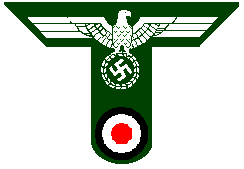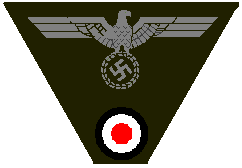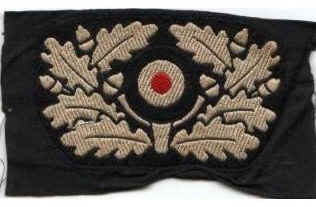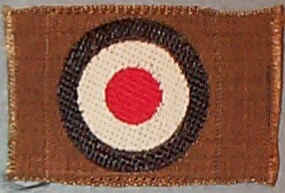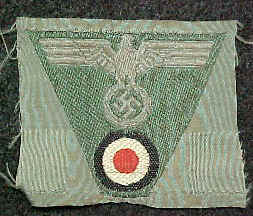| Feldmütze This cap, often referred to as either an
"M34" or "M38" by collectors, was introduced in 1934, and by 1939 had
undergone minor variations. The hat was boat shaped, with flaps on the sides that
could be turned down - though they were not full fold downs like the Bergmütze or
Einheitsfeldmütze and offered only limited protection to the wearer.
This type of cap was quite boxy in
appearance, and despite regulations forbidding it, individual soldiers often sewed the
material in the crown closed, giving the cap a more tapered appearance. |

|
| Bergmütze This cap was introduced in the ealry 1930s, and was
based on caps worn by Austrian Mountain Troops in World War One. Intended for wear
by Gebirgsjäger (Mountain Troops), Jäger (Light Infantry) and Ski troops, it later
inspired both the tropical field cap and the general issue "M43" cap. A
fold down side panel could provide protection for the neck and ears when in the field; it
was normally worn buttoned in place over the peak. |

|
| Schutzmütze ("Panzer
Beret") The
tankers beret was not popular with vehicle crews, one reason being the inability to wear
it with the required headsets. The beret was discontinued in January 1941 to be
replaced officially with the black Feldmütze. A field grey version was also issued
to the crews of Assault Guns, to wear in conjunction with the field grey AFV uniform.. |

|
| Feldmütze
("Panzer") Based
on the 1934 pattern Enlisted Men's Cap, the black version for vehicle crews was not
introduced until March 1940.
The example at right has a lemon yellow
soutache, and a cockade on dark green rather than black. |

|
| Tropeneinheitsfeldmütze The Tropeneinheitsfeldmütze was introduced in 1941
for troops serving in North Africa. It was similar to the Bergmütze, being made in
tan cotton, but with a longer visor to provide more protection from the sun. The cap
was lined in red cotton.
At right, an Afrikakorps NCO wears the
tropical field cap; note the length of the visor.
US Army Signal Corps
photo 1206030 |

|
| Feldmütze
("M42") The design
of the Feldmütze was changed in July 1942 (and consequently called an M42 by collectors),
to incorporate a full fold down side panel, buttoned at the front, which could cover the
neck and ears. The pattern was similar to the Bergmütze, but lacking the
visor. It was also produced in black for armoured troops. |

|

At left, the 1942 version of the Feldmütze, at right the
earlier version.
|
Einheitsfeldmütze
("M43")
Based on the Bergmütze, the Einheitsfeldmütze had a slightly
shorter peak, and was introduced in June 1943 to replace all other field caps then in use.
It was also made in black for armoured troops.

Albert Kerscher, holder of the Knight's Cross with
Oakleaves, wearing the black "M43" cap.
|

|

|



























